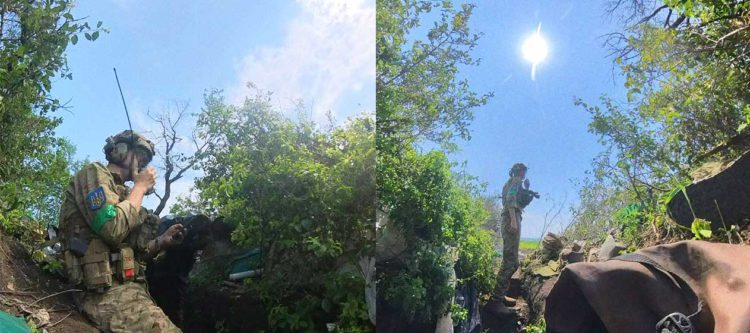The view from the front lines – keeping Ukraine’s defensive forces connected

On February 24, 2022, Russia invaded Ukraine. In the almost two years of fighting that followed the invasion, there have been more than 500,000 casualties, and more than 6 million Ukrainians have been uprooted from their lives and forced to live as refugees.
As Russia amassed troops on Ukraine’s borders months before the invasion, many pundits and military experts predicted a short conflict and a definitive, swift Russian victory. According to an editorial by Washington Post foreign affairs columnist David Ignatius, “The vast army that Russia has arrayed along Ukraine’s borders could probably seize the capital of Kyiv in several days and control the country in little more than a week.”
But, despite its small size and limited military capacity, Ukraine has persevered. The country recently launched a counteroffensive against Russia.
Even more impressive is that they’ve accomplished this with minimal communications capabilities – as their incredibly sophisticated adversary has compromised their communications at every turn. Knowing the importance of effective communication in modern warfare, Russia has leveraged its capabilities to degrade and deny Ukraine’s terrestrial and satellite communications networks since the beginning of the invasion – and to great effect.
According to the New York Times, “the breakdown in communication is a widespread issue across the [Ukrainian] front lines and touches nearly every aspect of the war — coordination on the battlefield, delivering supplies, and troop movements.” According to the Associated Press, improved Russian electronic warfare systems have destroyed about 10,000 Ukrainian drones a month. At the same time, they also have been able to intercept and decrypt Ukrainian tactical communications in real-time.
“…positional reports require people getting on the radio and then someone in the tactical operation center plotting their coordinates on the map…if the radio goes down, you might not know where your forces are.”
Communications are essential in modern warfare, where information is mission-critical. Communication helps increase situational awareness and ensures that an entire force has a single, common operating picture. It allows the sharing of data that is essential in strategic decision-making. And – at its most basic level – it enables important collaboration of forces and the dissemination of orders.
The Last Mile recently had the opportunity to speak with a volunteer in Ukraine who is assisting on the front lines. During our conversation, he discussed the communication challenges those defending their homeland were forced to overcome and the creative ways and innovative technologies they use to enable comms when traditional networks become denied or degraded.
Destroyed, degraded, and weaponized networks
From the outset of the war, it became clear that Russia recognized the mission-critical nature of communications networks for Ukraine’s defensive operations and worked to deny them. A recent report from the United Nations found significant damage to Ukraine’s telecommunications infrastructure during the first six months of the war. According to a UN agency, “Ukraine will need at least $1.79 billion to restore its telecommunications sector to pre-war levels…”
The damage to terrestrial telecom networks has made cellular connectivity unreliable, especially as troops enter the austere environments in contested areas.
“…you can somewhat rely on cellular networks when you’re outside of what I would call ‘short-range missile’ or ‘artillery threat’ range,” our contact explained. “For example, if I’m in Kyiv, I can talk to all my units in a relatively secure [fashion]. The problem really [increases] the closer you get to the front lines.”
However, the use of cell phones for communications and information sharing goes from unreliable to downright dangerous as you get closer to the fighting.
“Not only do the cell phone networks go down – which can sometimes be the case – but we operate with the bigger fear that the cell phone network is active and actually on the Russian cell phone network,” said the volunteer. “If your phone has just switched to [a Russian network], it allows them to locate where you are…and they’re pretty good at figuring that out.”
The Russian military knows that communications are essential to a collaborative and effective defense and that desperate Ukrainian defensive forces might resort to cellular networks to communicate. Because of this knowledge, they’ve implemented ways to weaponize cellular networks and communications against their adversaries.
Today’s frontline seeks communication options beyond cellular networks, voice radios, and satellite communications. According to our contact, when Ukrainian units spread out over large geographic distances, their adversaries are less capable of jamming communications. However, in places where they control small pieces of land or if all units aggregate in one place, jamming becomes a significant problem. The volunteer also explained that if a situation becomes dire or fiercely contested, Russians can focus their jamming on a small geographic area and potentially deny radio comms for days.
“…satellite communications were not working…or were overburdened because people were shifting to them en masse. Worse, using satellite connectivity is not always a great option because it requires units to be exposed…”
Communication challenges go beyond basic hand-held radio devices. It also extends to the satellite terminals and services that have garnered media attention for their ability to reestablish comms for the Ukrainian forces. “…satellite communications were not working [because of jamming] or were overburdened because people were shifting to them en masse,” our contact described. “Worse, using satellite connectivity is not always a great option because it requires units to be exposed, which can highlight their location to Russian drones and reconnaissance teams calling for kinetic strikes.”
This lack of reliable, assured, and secure communications led Ukrainian forces conducting mission planning and tracking to revert to surprisingly archaic methods such as paper or compass-based tactics.
Pushpins and voice radios
American military forces have capabilities that allow senior leaders to track the movement and locations of their troops. However, in Ukraine, defensive forces resort to tried and true methods that are more “industrial age” than “information age.”
“…positional reports require people getting on the radio and then someone in the tactical operation center plotting their coordinates on the map,” Our contact explained. “…if the radio goes down, you might not know where your forces are.”
According to the volunteer, this lack of visibility into troop locations and troop movements can be a significant problem for mission tracking – which can have ramifications on mission success, “It’s important when an offensive operation is happening – or if the enemy is moving and you have units trying to figure out the best location on the battlefield – to have a more stable way to battle track.”
But there is another secure, assured, and reliable way to enable communications and situational awareness for Ukrainian forces.
Mobile mesh makes its way to the front lines
Considering the communications challenges that have plagued the Ukrainian defensive forces, the ability to instantly create ad hoc, decentralized networks would be incredibly beneficial. This kind of near-peer fight requires mobile mesh networking solutions.
By leveraging an inexpensive, rapidly deployable, and secure mobile mesh networking solution – such as the goTenna Pro X Series – Ukrainian defensive forces can transmit mission-critical data, communicate via text, and see each other’s locations on a map. This solution improves information-sharing, enables a more coordinated and collaborative defense, and enhances mission tracking and planning.
Our contact in Ukraine supported this approach: “Mobile mesh networks are optimal for securely battle tracking in austere situations.”
The network is self-healing since mobile mesh networking radios – or nodes – each receive and retransmit a signal. If a single mesh networking node is denied or destroyed, the rest of the network continues to operate. This mobile mesh networking technology is a valuable alternative to traditional radio and satellite communications because it can’t be taken offline with a single node – like a terminal or repeater.
“…the breakdown in communication is a widespread issue across the [Ukrainian] front lines and touches nearly every aspect of the war — coordination on the battlefield, delivering supplies, and troop movements.”
A short-burst, narrow-band transmission from a mesh radio, like the Pro X Series, can be more challenging for an adversary to identify, thus providing some additional safety to fighters on the front lines. “Today’s advanced mobile mesh networking solutions are ideal for warfighters facing more sophisticated adversaries,” goTenna’s Mike Reagan explained in a previous article on The Last Mile. “These transmit quickly – with transmission times of less than a second. This short transmission time makes it significantly harder to discover and use the signal to identify troop locations.”
The short-burst nature of messages and the Aspen Grove protocol within goTenna devices can operate effectively through barriers, underground, and in dense canopies. As the Founder and CEO of Big Bison Logistics, Todd Sheets, recently told The Last Mile, “…in an entirely underground environment – cellular networks were completely unavailable. Mobile mesh became our primary form of communication, and we were able to stay online.” Mobile mesh networking can operate in many austere or disconnected environments, keeping operators connected while keeping their locations and movements secure.
Considering the sophistication and military might of the adversary it faces, Ukraine has risen to the occasion and managed to keep the upper hand in an invasion that many thought would be over quickly and decisively. This feat is even more impressive because they have struggled with denied and degraded communications since the outset.
Ukraine’s defense forces need a communications tool to deliver mission-critical connectivity and situational awareness, even when adversaries deny other solutions. Mobile mesh networking is the key to keeping its forces connected even when voice radios, cellular networks, and satellite communications become compromised.









No Comment